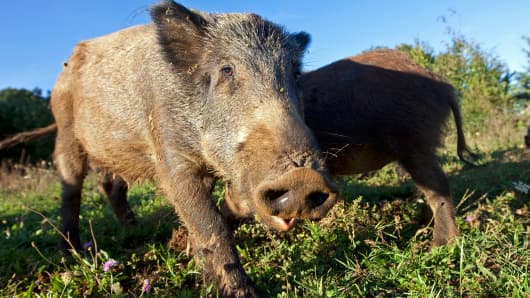"Mr. Fisher used 'feral hogs' as a reference. We all know bulls and bears make money and hogs get slaughtered," said Ben Willis, managing director with Albert Fried, on CNBC's "Closing Bell." "Overall, I still think the market has some work to do on the downside."
The Dow had moved in a wide range and was down just double digits for part of the afternoon.
But the reversal in rates had some bond market analysts looking for a near-term top in yield.
"It was the culmination of the four Fed speakers since Friday. We effectively had two issue their own FMC statements—Bullard and Kocherlakota," said CRT Capital senior Treasury strategist Ian Lyngen.
"I understand that they're uncomfortable with the price action, and similarly Dudley came out with his views and Fisher with the wild boar reference. If anyone could ever be concerned there was a coordinated Fed communications response to price action this was it."
New York Fed President William Dudley also spoke Monday, as did Minneapolis Fed President Narayana Kocherlakota. Kocherlakota, a nonvoting member said he was not worried about the market's short-term reaction to the Fed, but would be concerned if it continued. He also laid his own view on the Fed QE program, saying it should buy assets until the unemployment rate has fallen below 7 percent.
Fisher also said it made sense to "socialize the idea that quantitative easing is not a one-way street," and that ending it would be done cautiously. "I don't want to go from Wild Turkey to cold turkey overnight," he said.
On Friday, St. Louis Fed President James Bullard released a statement on why he dissented at the Fed's meeting last week. Bullard said he was concerned the move to taper purchases is premature and he is worried there needs to be more tangible signs of economic improvement.
Bullard also thought the Fed should have signaled more willingness to defend its 2 percent inflation target, according to the St. Louis Fed.
(Read More: Bernanke Should Keep Buying Bonds: Fed Official)
Rising interest rates have been stinging stocks, and some traders have been chatting about at what point stocks could weaken enough to make the Treasury market look like a safe haven once more.
Bank of America Merrill Lynch global head technical strategist MacNeil Curry points out that the breakdown in the S&P 500, through key support at 1,597/1,600 now makes the 1,540/1,536 area an important area of support before the 200-day moving average, which is way down at 1,506. The S&P 500 fell 19 to 1,573 Monday.
"This weakness should increase the potential for a 'flight to safety' bid in U.S. Treasuries, likely resulting in pause or period of consolidation from the recent selloff," he wrote. "However, we must stress that yield pullbacks should be seen as temporary and corrective of the larger bear trend."
He said the 10-year yield could head back to 2.420/2.219 percent, before moving back up to bearish levels of 2.857/2.951 percent.
—By CNBC's Patti Domm.





